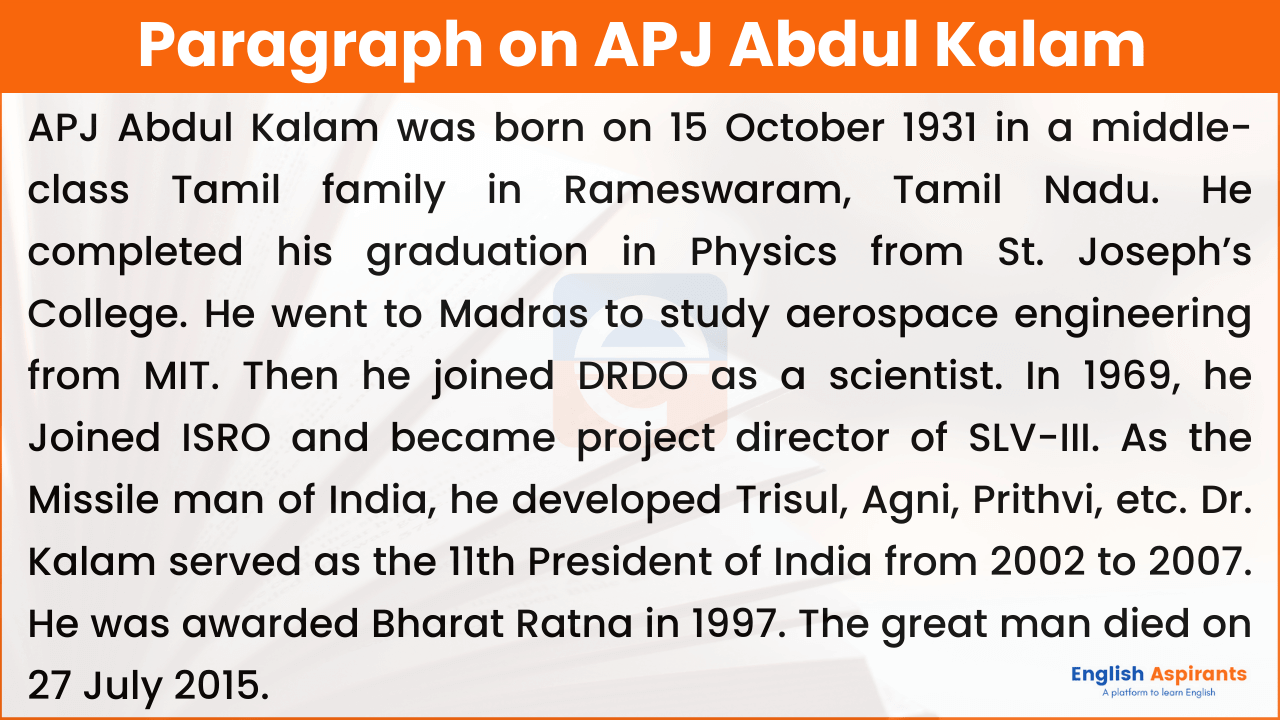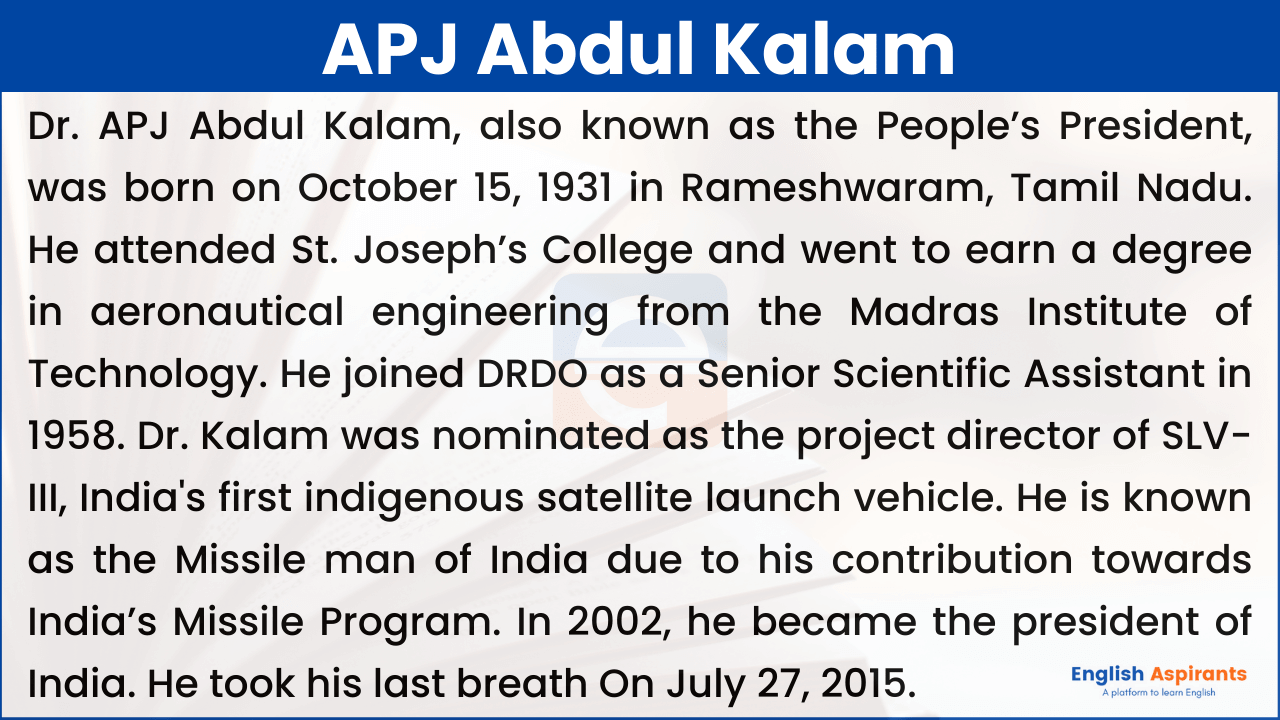Paragraph on APJ Abdul Kalam in English: Dr. APJ Abdul Kalam was a great scientist and politician. He devoted his life to the service of the motherland. In this article, you are going to 4 paragraphs on APJ Abdul Kalam in English (100, 150, 200, and 250 words). All the paragraphs will be helpful for students of class 1 to class 12. So, Let’s get started.
Table of Contents
Paragraph on APJ Abdul Kalam: 100 Words
APJ Abdul Kalam was born on 15 October, 1931 in a middle-class Tamil family in Rameswaram, Tamil Nadu. He completed his graduation in Physics from St. Joseph’s College. He went to Madras to study aerospace engineering from MIT.
Then he joined DRDO as a scientist. In 1969, he Joined ISRO and became project director of SLV-III. As the Missile man of India, he developed Trisul, Agni, Prithvi, etc. He was appointed as the Chief Scientific Adviser to the Prime Minister and Secretary of DRDO.
Dr. Kalam served as the 11th President of India from 2002 to 2007. He wrote many famous books like Wings of Fire, Mission India, Target 3 Billion, etc. He was awarded Bharat Ratna in 1997. The great man died on 27 July 2015.

APJ Abdul Kalam Paragraph: 150 Words
Dr. APJ Abdul Kalam, also known as the People’s President, was born into a Muslim family on October 15, 1931 in Rameshwaram, Tamil Nadu. He attended St. Joseph’s College and went to earn a degree in aeronautical engineering from the Madras Institute of Technology. He joined the Defence Research and Development Organization (DRDO) as a Senior Scientific Assistant in 1958.
Dr. Kalam was nominated as the project director of SLV-III, the first satellite launch vehicle designed and produced on Indian soil. He became the senior scientific adviser of India’s Defence Ministry in 1992, a position through which he used to campaign for the development of nuclear tests. Kalam was a key figure in the May 1998 Pokhran ll tests. He is known as the Missile man of India due to his contribution towards India’s Missile Programme.
In 2002, he became the president of India. On July 27, 2015, Kalam suffered a massive heart attack and breathed his last at the age of 83.


Also Read: Essay on APJ Abdul Kalam
Paragraph on APJ Abdul Kalam: 200 Words
Avul Pakir Jainulabdeen Abdul Kalam popularly known as ‘Missile man’ was born on October 15, 1931 into a middle-class Tamil family in Rameswaram, Tamil Nadu. Kalam completed his school education from Schwartz Higher Secondary School. Then he graduated in Physics from St. Joseph’s College. In 1960, he completed his course on aeronautical engineering from the Madras Institute of Technology.
Then, he joined the Defence Research and Development Organization as a scientist. In 1969, he joined ISRO and worked as the project director of SLV-III, India’s first indigenous Satellite Launch Vehicle. Kalam became the senior scientific adviser of India’s Defence Ministry in 1992, a position through which he used to campaign for the development of nuclear tests. Dr. Kalam played a pivotal role in India’s Pokhran-II nuclear test in 1988.
He won the prestigious award Bharat Ratna in 1997. He was also conferred with Padma Bhushan in 1981 and Padma Vibhushan in 1990. In 2002, he became India’s President. Dr. Abdul Kalam wrote many books. Some of them are The Luminous Sparks, Mission India, Wings of Fire, Inspiring Thoughts, etc. On July 27, 2015, Kalam suffered a massive heart attack and breathed his last at the age of 83.
APJ Abdul Kalam Paragraph: 250 Words
Avul Pakir Jainulabdeen Abdul Kalam, better known as A.P.J. Abdul Kalam was born on October 15, 1931 in Rameswaram, India. After completing his school education from Schwartz Higher Secondary School he got admitted to St. Joseph’s College. In 1954 he graduated in Physics. In 1960, He completed his course on aerospace engineering from MIT.
He was an Indian scientist and politician who played a key role in the development of India’s missile and nuclear weapons programs. As a scientist by profession, he worked with the Indian Space Research Organisation (ISRO) and Defense Research and development organization (DRDO) as an aerospace engineer before assuming his role as the president of India.
Appointed as the eleventh president of India, Kalam served his term in office from 2002 to 2007. Kalam authored numerous famous books including Wings of fire, Mission India, Indomitable Spirit, Inspiring Thoughts, and many more.
He was one of the few presidents who touched the hearts of millions of people and left an indelible imprint on their minds. It is owing to this popularity he enjoyed among the masses that he came to be called the People’s President.
Dr. Abdul Kalam was awarded the country’s highest honor, the Bharat Ratna, in 1997. He also received Padma Bhushan in 1981 and Padma Vibhushan in 1990. His work on the development of launch vehicle and ballistic missile technology earned him the name ‘Missile Man of India’. A.P.J. Abdul Kalam died on 27 July 2015 from a sudden cardiac arrest.
Frequently Asked Questions (FAQs) on APJ Abdul Kalam
Dr. Abdul Kalam is known as the ‘Missile Man of India’. He wrote many famous books. Some of them are Inspiring Thoughts, Wings of Fire (Autobiography), Mission of India: A Vision of Indian Youth, Ignited Minds: Unleashing the Power within India, My Journey, Mission India, The life tree, etc.
He was awarded Padma Bhushan in 1981, Padma Vibhushan in 1990 and Bharat Ratna in 1997. He was also a recipient of Honorary doctorates from many universities across the world.
Wheeler Island, located in Odisha, is known as Dr. Abdul Kalam Island.
APJ Abdul Kalam died on 27 July 2015, at the age of 83 while delivering a lecture at the Indian Institute of Management Shillong. Kalam collapsed and died from an apparent cardiac arrest.
Read More Paragraphs:
1. Paragraph on Rabindranath Tagore
2. Paragraph on Swami Vivekananda
3. Paragraph on Mother Teresa
4. Paragraph on Ishwar Chandra Vidyasagar




